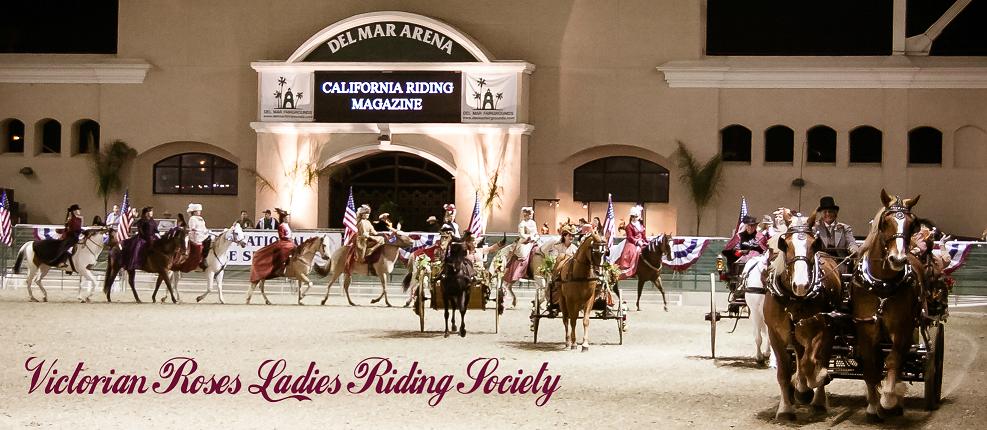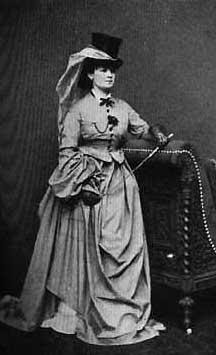1810-20s
 |
| 1820s Silk Habit Philadelphia Museum of Art |
This fashion plate (right) shows an early 19th Century habit from 1816. They were frequently made in wools of a darker color. The habits had influences from masculine garments and military uniforms. She wears a delicate white cravat. New York Public Library's photo collection.
1830s
Riding pants were worn by women under their habit skirts as early as the 1830s. These trousers were crafted long and covered the legs completely.
 |
| 1829-30 habit Museum of London |
 |
| Riding spencer circa 1835 From LACMA |

An extremely rare brown wool `Amazone' or riding habit, circa 1835-8, the one-piece gown with triple row of satin covered buttons to the bodice, broad collar, the sleeves with pleated mancherons, elongated skirt for riding side-saddle, lined in brown cotton liveauction.com
1840s
Below left, Fashion plate January, 1849 Godey's Lady's Book Riding
dress for the country.— "Leghorn hat, with a rolled brim, the dress a
full skirt of pale drab-colored cashmere, fastened up the front by a
close row of very small silk buttons of the same color. A “Jack
Sheppard” waist (see Lady's Book for November) of nankeen, with a rich
white linen braid embroidery on the front and sleeves. The short skirt,
or basque, is trimmed in the same way as the waist, and hued with pale
blue Florence silk. Plain linen collar and cuffs, and a blue ribbon neck
tie. Gloves as near as possible the shade of the waist."
1850s
Below left, 1858-59. Mary Toogood wears a fitted bodice instead of a jacket with a long basque and peplum. Although she does not wear a hoop under her skirt for the photographer, it does look like she is wearing a small bustle to support the peplum of her bodice. source

Right, 1858-59. "One can clearly see her long fitted button down bodice with it's long skirt like basque. The way her skirt drapes is also visible. It is shorter on the right side and trains to the left so that when mounted, there would be slightly less bulk under the right leg yet still allowing for the long skirt to hang right down on the left side. If the rider rode on an off-side saddle, the habit's skirt would be cut to train on the right side." see source above
1860s
Left, Miss C. Weston from Brady-Handy Collection At least one skirt elevator visible, between her hands; other places, the skirt seems to be looped up/tied inside. Right, 1868. You can see her petticoat underneath.
 "The best dressed Victorian horsewoman often did without her petticoats when riding and wore nothing more than a flannel chemise with long colored sleeves under her trousers. Ladies’ trousers were of the same material and color as the riding habit. The trousers were sometimes full and flowing “like a Turk’s” and fastened with an elastic band round the ankle, indistinguishable from the skirt. In this riding costume, which was made amply warm by the folds of the trousers plaited like a Highlander’s kilt and fastened with an elastic band at the waist, the Victorian lady could sit down in a manner impossible for one encumbered by two or three short petticoats. Nevertheless, some ladies preferred a quilted petticoat that was not too full. It was lined with silk or glazed muslin." source
"The best dressed Victorian horsewoman often did without her petticoats when riding and wore nothing more than a flannel chemise with long colored sleeves under her trousers. Ladies’ trousers were of the same material and color as the riding habit. The trousers were sometimes full and flowing “like a Turk’s” and fastened with an elastic band round the ankle, indistinguishable from the skirt. In this riding costume, which was made amply warm by the folds of the trousers plaited like a Highlander’s kilt and fastened with an elastic band at the waist, the Victorian lady could sit down in a manner impossible for one encumbered by two or three short petticoats. Nevertheless, some ladies preferred a quilted petticoat that was not too full. It was lined with silk or glazed muslin." sourceRight, “Emma Cochran June 1863": Full-length portrait of a woman identified as Emma Cochran from Ball & Thomas’ Photographic Art Gallery, 120 West Fourth Street, near Race, Cincinnati, O. LC-DIG-ppmsca-10948
1870s
 Right, "The first “safety skirt” was invented in 1875, which buttoned along the
seams to help stop accidents where women were dragged by
their horses, and sometimes crushed beneath a rolling mount, during a
tumble. This safety skirt later morphed into an apron skirt, which was
worn buttoned around the waist, just covering the legs (which were
encased in breeches)." Source
Right, "The first “safety skirt” was invented in 1875, which buttoned along the
seams to help stop accidents where women were dragged by
their horses, and sometimes crushed beneath a rolling mount, during a
tumble. This safety skirt later morphed into an apron skirt, which was
worn buttoned around the waist, just covering the legs (which were
encased in breeches)." SourceAbove and below, 1875 green wool habit from the Met Museum. Detail of draping, hidden under the back of the jacket

Right, military inspired habit with bowler type hat.
1880s
Following the fashion trends of the 1880s, riding habits were very form fitting.


In 1885, snap fasteners were invented, and shortly after that a new version of the safety skirt for riding was made that would tear open along the line of snaps if a lady fell.
1890s
Christy's Auctions
 |
| The Metropolitan 1890s Riding Habits |

Photo from Panhandle Plains Museum in Canyon, Texas.
"Equestrienne in bowler hat, stylish gauntlets, and with horsehair quirt, stands beside her horse, which has a horsehair bridle and cowgirl-style, double-rigged, heavily carved sidesaddle" late1890s.
Above- riding habits from 1895, 1898, and 1900. Bowler hats had become acceptable. The photo is interesting as it shows the woman’s trousers and boots. Source
Just Because....Side Saddle Ostrich Races!
 | ||||
Submitted by Shenandoah Rose.












